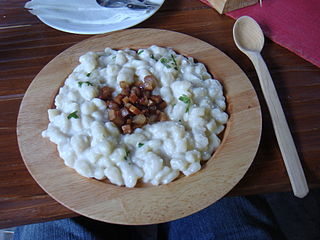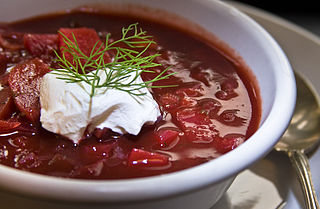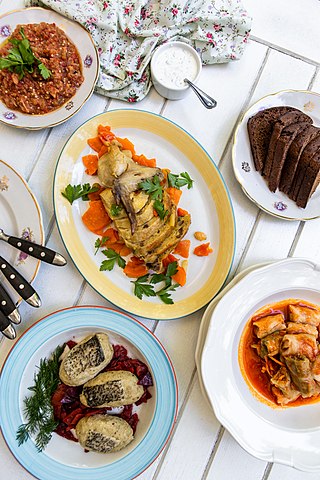
Hungarian or Magyar cuisine is the cuisine characteristic of the nation of Hungary, and its primary ethnic group, the Magyars. Hungarian cuisine has been described as being the spiciest cuisine in Europe. This can largely be attributed to the use of their piquant native spice, Hungarian paprika, in many of their dishes. A mild version of the spice, Hungarian sweet paprika, is commonly used as an alternative. Traditional Hungarian dishes are primarily based on meats, seasonal vegetables, fruits, bread, and dairy products.
Knödel or Klöße are boiled dumplings commonly found in Central European and East European cuisine. Countries in which their variant of Knödel is popular include Austria, Bosnia, Croatia, Czechia, Germany, Hungary, Poland, Romania, Serbia, Slovakia and Slovenia. They are also found in Scandinavian, Romanian, northeastern Italian cuisine, Ukrainian, Belarusian and French (Alsatian) cuisines. Usually made from flour, bread or potatoes, they are often served as a side dish, but can also be a dessert such as plum dumplings, or even meat balls in soup. Many varieties and variations exist.

Goulash is a soup or stew of meat and vegetables seasoned with paprika and other spices. Originating in Hungary, goulash is a common meal predominantly eaten in Central Europe but also in other parts of Europe. It is one of the national dishes of Hungary and a symbol of the country.

Meze is a selection of small dishes served as appetizers in Albanian, Bosnian, Armenian, Kurdish, Levantine, Turkish, Bulgarian, Greek, Iraqi, Egyptian, and Iranian cuisine. It is similar to Spanish tapas and Italian antipasti. A mezze may be served as a part of a multi-course meal or form a meal in itself. In non-Islamic countries, or in areas without alcohol restrictions, mezze are often served with spirits such as arak, rakia, raki, oghi or grappa.

Pierogi or pierogies are filled dumplings, made by wrapping unleavened dough around a filling, and occasionally flavored with a savory or sweet garnish, finally cooked in boiling water.

Austrian cuisine is a style of cuisine native to Austria and composed of influences from Central Europe and throughout the former Austro-Hungarian Empire. Austrian cuisine is most often associated with Viennese cuisine, but there are significant regional variations.

Obatzda is a Bavarian cheese spread. It is prepared by mixing two thirds aged soft cheese, usually Camembert and one third butter.
Romanian cuisine is a diverse blend of different dishes from several traditions with which it has come into contact, but it also maintains its own character. It has been mainly influenced by Turkish but also a series of European cuisines in particular from the Balkan Peninsula and Hungarian cuisine as well as culinary elements stemming from the cuisines of Central Europe.

Bryndza or brynza is a sheep milk cheese made across much of East-Central Europe, including in Ukraine and Slovakia. Bryndza cheese is creamy white in appearance, known for its characteristic strong smell and taste. The cheese is white, tangy, crumbly and slightly moist. It has characteristic odor and flavor with a notable taste of butyric acid. The overall flavor sensation begins slightly mild, then goes strong and finally fades to a salty finish. Recipes differ slightly across countries.

Slovak cuisine varies slightly from region to region across Slovakia. It was influenced by the traditional cuisine of its neighbours and it influenced them as well. The origins of traditional Slovak cuisine can be traced to times when the majority of the population lived self-sufficiently in villages, with very limited food imports and exports and with no modern means of food preservation or processing.

Bulgarian cuisine is part of the cuisine of Southeast Europe, sharing characteristics with other Balkan cuisines. Bulgarian cooking traditions are diverse because of geographical factors such as climatic conditions suitable for a variety of vegetables, herbs, and fruit. Aside from the variety of local Bulgarian dishes, Bulgarian cuisine shares a number of dishes with its neighboring countries, in particular with Turkish and Greek cuisine.

Smetana is the English-language name for the types of sour cream traditionally prevalent in Central, Eastern, and Southeastern Europe. It is a dairy product produced by souring heavy cream. It is similar to crème fraîche, but nowadays mainly sold with 9% to 42% milkfat content depending on the country. Its cooking properties are different from crème fraîche and the lighter sour creams sold in the US, which contain 12 to 16% butterfat. It is widely used in cooking and baking.

Lecsó is a Hungarian thick vegetable ragout or stew which traditionally contains yellow pointed peppers, tomato, onion, salt, and ground sweet and/or hot paprika as a base recipe. The onions and peppers are usually sauteed in lard, bacon fat, or sunflower oil. Garlic can also be a traditional ingredient. It is also considered to be traditional food in Czech, Slovak and former Yugoslavian cuisine and is also very common in Poland, Austria, and Israel.

Stuffed peppers is a dish common in many cuisines. It consists of hollowed or halved bell peppers filled with any of a variety of fillings, often including meat, vegetables, cheese, rice, or sauce. The dish is usually assembled by filling the cavities of the peppers and then cooking.

Hungarian sausages are sausages found in the cuisine of Hungary. Hungary produces a vast number of sui sausage types. They may be boiled, fresh or dried, and smoked, with different spices and flavors, "hot" or "mild". Many were influenced by their neighbors and brethren.

The traditional cuisine of Abruzzo is eclectic, drawing on pastoral, mountain, and coastal cuisine. Staples of Abruzzo cuisine include bread, pasta, meat, fish, cheese, and wine. The isolation which has characterized the region for centuries has ensured the independence of its culinary tradition from those of nearby regions. Local cuisine was widely appreciated in a 2013 survey among foreign tourists.

Fisherman's soup or halászlé is a hot, spicy paprika-based fish soup. A folk item of Hungarian cuisine, it is a bright-red hot dish prepared with generous amounts of hot paprika and carp or mixed river fish. It is native to the Pannonian Plain, particularly the Danube and Tisza river regions. It is also a popular dish among ethnic German Donauschwaben and their descendants, known as Karpfensuppe. In Croatia, it is commonly served in the regions of Slavonia and Baranya, where it is called fiš paprikaš.

The cuisine of Odesa, Ukraine is influenced by various cultures and regions, including Russia, Jewish culture, Georgia, France, Germany, Italy, Armenia, Uzbekistan, Bulgaria, Moldova, and Greece. However, many recipes are indigenous to Odesa, with fusion cuisine being common.

















